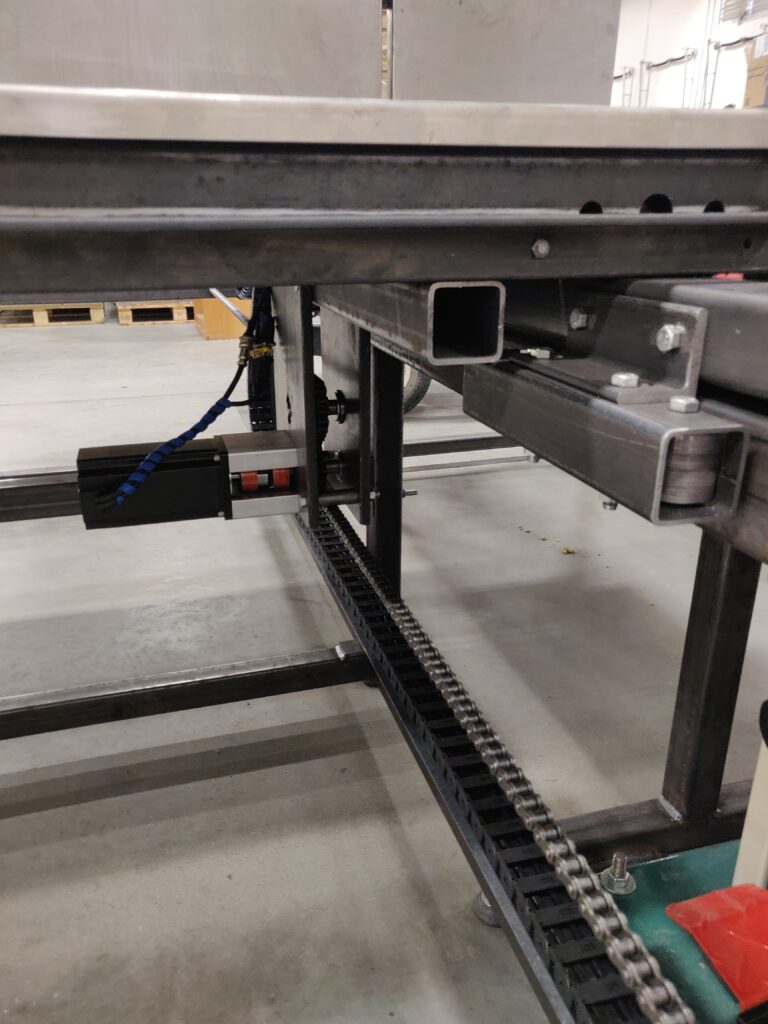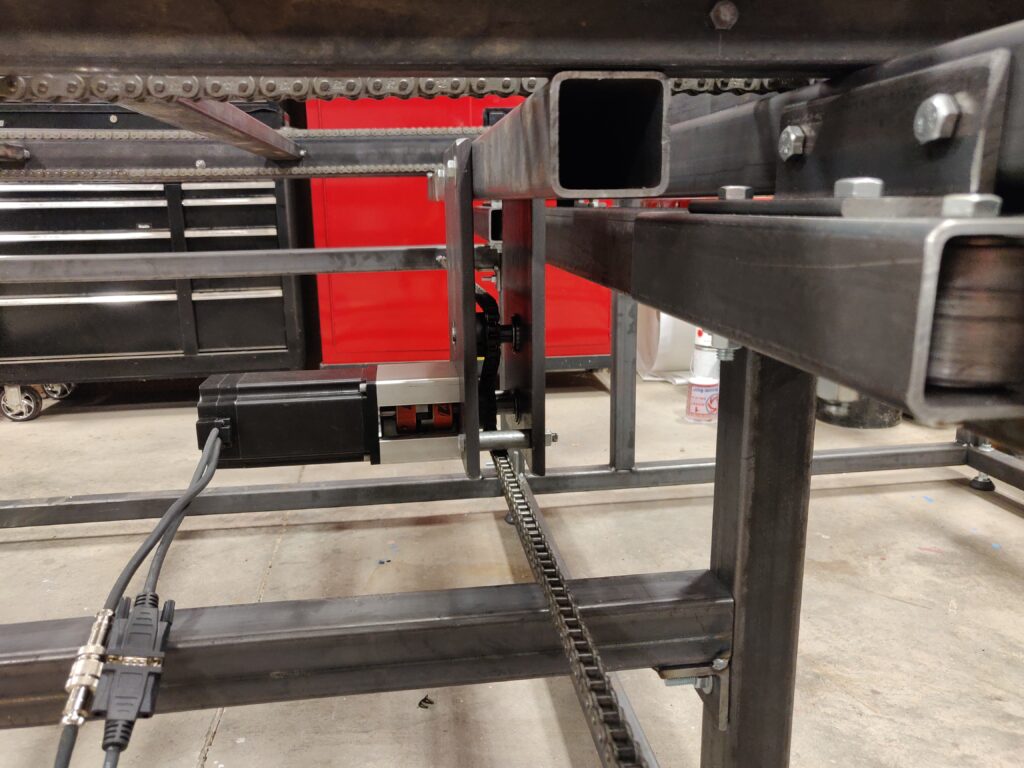Computer Controlled Bandsaw
R.N.C. Industries, Inc. makes insulation inserts for cardboard boxes. The insulation inserts are made of ROCKWOOL wrapped in plastic. In order to make the inserts for custom size boxes, normally the company has workers cut the ROCKWOOL into rectangles on bandsaws. This requires the workers to interpret various cut sheets and manually measure out the cuts. This method leads to a large reliance on the worker and a potential for inconsistency. The computer controlled bandsaw solves both of these problems and is a very repeatable, elegant solution.
The computer controlled bandsaw (CCB) works with two axes of motion: the first is the cutting motion and the second is the indexing motion. The cutting motion is created by sliding an entire table back and forth on rails on one side of the blade. Bundles of the ROCKWOOL are placed on this sliding table and pushed up against the back fence. The table then moves forward through the bandsaw blade to complete a cut. The length of that cut is determined by the indexing motion. This motion is created by a mobile fence built onto the sliding table. The indexing fence moves the bundle of ROCKWOOL a specified distance, and then the sliding table moves forward through the bandsaw blade generating the cut. A video of the final machine can be seen below:
The CCB is driven by a Raspberry Pi4 controlling an Arduino Mega 2560. The Raspberry Pi controls a touch screen where the operator of the machine selects an excel file containing information about the cut sheet. Once the excel sheet has been uploaded, the Raspberry Pi sends a letter code to the Arduino. Each letter in the code corresponds to a specific cut length. The order of the letters tells the Arduino the order of cuts that the CCB needs to perform. The Arduino converts the cut distances into pulses and sends the pulses to two NEMA 34 closed loop stepper motors: one to index the mobile fence and the other to move the sliding table. To control the CCB, all the operator needs to do is press a button on the control panel. The Arduino updates an LCD screen on the control panel with the previous cut and next cut every time the button is pressed informing the operator about exactly what the CCB is doing at all times. The control panel also includes a repeater switch which enables the operator to continue running cycles of the uploaded cut sheet until the repeater is switched off. The final switch on the control panel is a size switch which changes the travel distance of the sliding table allowing the CCB the flexibility to cut 36 X 48 inch bundles and 48 X 72 inch bundles of ROCKWOOL. The face plate of the control panel was 3D printed in-house to accommodate the custom layout needed.



The wiring for the CCB is all custom and completed in-house at R.N.C. The signal wires for the LCD screen and the button and switches needed bespoke cables running between the power box to the control panel. The Raspberry Pi and Arduino communicate through a serial print cable. Two power supplies are needed. One 48 volt to power the two motors and their respective controllers, and one combined 12 volt / 5 volt power supply that give 12 volts to the Arduino and 5 volts to the Raspberry Pi and touch screen.
The entire CCB was designed from scratch. First, the CCB was designed entirely on Solidworks. This made making a parts list and drawings for the fabrication of parts a much more streamlined process. As the Solidworks model was approaching completion, we finished up the initial coding for the machine. The code came in two parts: the Raspberry Pi runs on python and the Arduino runs on C++. The python code involved mainly converting the excel file data into a form that could be sent to the Arduino through the serial communication cable as well as generating the interface on the touch screen for uploading the excel files. The C++ code is where the bulk of the CCB control occurs. The Arduino code receives the letter code from the Raspberry Pi and converts it into pulses to control the closed loop stepper motors. The C++ code also updates the LCD screen throughout the cutting cycle and uses the button and switches to change the actions of the CCB accordingly. There are 4 different cases for how the bundle of ROCKWOOL needs to be cut, and the Arduino code changes the motions of the mobile fence and sliding table to match each case. The 4 cases include a no scrap case, a 48 inch side scrap case, a 36 inch side scrap case, and a double scrap case. Of course, when cutting the 48 X 72 inch bundles the code adjusts the scrap sizes accordingly. To ensure that the scrap cases do not confuse the operator, the LCD screen updates to tell the operator when the CCB is cutting scrap. A video of the Solidworks assembly is shown below:
After the completion of the code and Solidworks, the CCB was fabricated completely in-house. We cut 2 X 2 steel tubing and various metal plates according to the drawings from the Solidworks and manufactured every part of the machine. The table slides on steel rollers made in-house and is driven by a chain system similar to a rack and pinion. The chain itself is always stationary while the closed loop stepper motor is connected directly to a sprocket with a love joy and drives the table back and forth along the chain. The mobile fence is connected to a chain and axle system. Two axles, one at either end of the sliding table, are connected with two chains on sprockets at the ends of the axles. The fence is driven using a closed loop stepper motor connected with a love joy to the rear axle.




